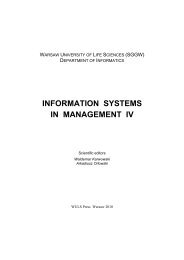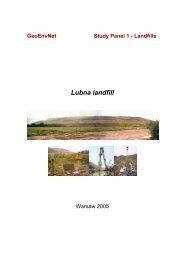ACTA SCIENTIARUM POLONORUM - SGGW
ACTA SCIENTIARUM POLONORUM - SGGW
ACTA SCIENTIARUM POLONORUM - SGGW
Create successful ePaper yourself
Turn your PDF publications into a flip-book with our unique Google optimized e-Paper software.
28 R. Hryniewski, W. Mądry, D. Gozdowski, B. Roszkowska-Mądrashare of grasslands (X2), cattle density (X9) and organic fertilizer use (X10). For thatreason, PC3, as factor 3, was called Grasslands and their utilization in cattle production.This factor describes the gradient of the grassland area, cattle density and organic fertilization,which is positively correlated with these attributes of the farming system.Cluster analysis and characterisation of the types of farming systemsThe surveyed farms were divided into five clusters (homogeneous groups). The decisionas to how to cut the branches of the dendrogram is a compromise between a sensiblenumber of identified groups and intra- and inter-group similarities [Krzanowski 2000,Köbrich et al. 2003, Serrano Martínez et al. 2004b]. The identified homogeneous groupsof farms are varied mainly for those diagnostic variables that define the first 3 principalcomponents (i.e. with which they are most strongly correlated), the first principal componentrepresenting the strongest correlation. Then, assumed in the paper numbers of thedistinguished groups of farms increase as the value of the first principal component (PC1)decreases, indicating an increasing gradient of the intensification and specialization incattle production (Table 4). The characterisation of each homogeneous group of farmsfor the major discriminating variables makes it possible to identify and describe comprehensivelythe distinguished types of farming systems in the surveyed population oftobacco farms [Köbrich et al. 2003, Blazy et al. 2009, Chavez et al. 2010]. On the basis ofa detailed analysis of group means for the most important diagnostic variables (Table 4),whose comparative results are presented in Table 5, a multi-dimensional characterisationof five specific types of farming systems found in tobacco farms in south-eastern Polandwas made. It is presented as follows:Type 1 farming system: A system of extensive crop-oriented, small profitable agriculturalproduction in moderate small, diversified in non-agricultural activity farmswith a small share of tobacco in arable areas and low contribution of agriculture tofarm household incomes, mainly tobacco-related.Type 2 farming system: An extensive smallholder not-diversified system with largefarm labour resources with a strong tobacco-oriented production and large contributionof agriculture to farm household incomes, mainly tobacco-related.Type 3 farming system: A system of developing, moderately intensive, diversifiedcrop-cattle production in rather large, slightly diversified in non-agricultural activity,farms with moderately large share of tobacco in arable areas and rather largecontribution of agriculture to farm household incomes, mainly tobacco-related.Type 4 farming system: A system of moderately intensive diversified crop-cattleproduction in large, poorly diversified in non-agricultural activity, farms withmoderately large share of tobacco in arable areas and rather large contribution ofagriculture to farm household incomes, mainly tobacco-related.Type 5 farming system: A system with low farm labour resources and intensivediversified crop-cattle production in large, not diversified in non-agricultural activity,farms with a small share of tobacco in arable area and a large contribution ofagriculture to farm household incomes, mainly not tobacco-related.Acta Sci. Pol.
















